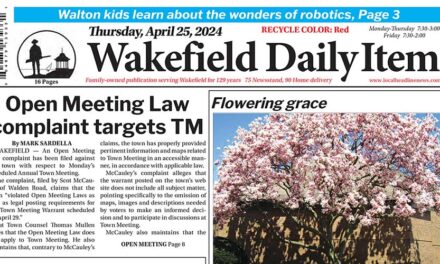By GAIL LOWE
WAKEFIELD — The words “student” and “homeless” used in a single sentence seems to be an incongruity but the fact is there are homeless students and a few attend classes in Wakefield’s schools.
In September, seven homeless students were enrolled in the district; in October, eight. Last January there were 11.
Homelessness does not come without a price, in terms of both emotional and societal costs as well as transportation costs.
Since September, transportation costs reached $8,348 in Wakefield for homeless students.
Superintendent of Schools Dr. Stephen K. Zrike pointed out at last night’s school board meeting that the cost is split between the student’s district of origin and Wakefield but that the money coming to Wakefield goes back to the town.
“Student homelessness is a financial burden on communities but it’s all for the benefit of the children,” he said.
In response to a question from school board member Gregory Liakos about sources to support homeless students, Zrike commented that school leaders in Wakefield are very aware of the problem and provide social and emotional support as needed.
Zrike spoke about student homelessness on behalf of Wakefield Academy Director Fred Randall. In addition to directing the Academy, Randall is the district’s homelessness liaison.
Zrike referred to the McKinney-Vento Homeless Education Assistance Act of 2002 and said that every homeless child has a right to school choice, along with transportation, nutrition, equal access and comparable services as outlined in Title 1.
(The purpose of Title 1 is to ensure that all children have a fair, equal and significant opportunity to obtain a high-quality education and reach, at a minimum, proficiency on challenging state academic achievement standards and state academic assessments.)
The McKinney-Vento Act is a federal law designed to ensure immediate enrollment and educational stability for homeless children. According to language in Zrike’s presentation, “Homeless is a journey — not an overnight event — that has enormous impact on children.”
“If students want to go to the school of their home origin, they can,” Zrike said. “If they choose another district, they can do that, too.”
According to the U.S. Department of Education, three-quarters of homeless students live “doubled up,” that is, with friends or extended family members, while 16 percent live in shelters. Some 3 percent live without shelter, and about 6 percent live “unaccompanied,” meaning they live completely on their own without parents or other family members. A significant number of homeless students have disabilities or limited English language skills.
Homelessness, as defined by the McKinney-Vento Act, extends to children living in campgrounds, shelters, cars, abandoned building, hotels or motels and those waiting to be placed in foster care.
Zrike pointed out that currently there is no policy concerning homelessness in the district but there needs to be one.
There is a fine line between temporary living situations and homelessness, Zrike said.
For example, if a parent goes to a school to enroll her grade two student and explains that she has just arrived in town and is living with her mother, yet she cannot prove residency and is unwilling to show a lease, is she housed or is she homeless?
Zrike said that building awareness among school board members and within the community is key in Randall’s role as homelessness liaison.
“We need to communicate with our counterparts (other towns),” said Zrike. “The key is training everyone, including enrollment staff, guidance counselors, principals and nurses.”
A record number of homeless students mean a record number of children being exposed to sexual trafficking, abuse, hunger and denial of their basic needs, according to Bruce Lesley, president of the First Focus Campaign for Children.
For more information about the student homelessness, www.naehcy.org or mahomeless.org.




